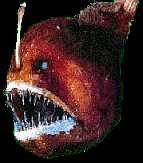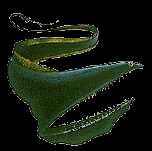The Channer Vent

Location
They call it
the "Ring of Fire"— a daisy-chain of volcanoes, faults, and crustal fractures
encircling the Pacific Basin. One of its nastier segments is
Juan de Fuca Ridge, an oozing gash along the northeastern edge of the Pacific.
The Axial Seamount is an undersea volcano at the southern tip of that Ridge.
Channer Vent sits on the northwest shoulder of the Axial Volcano. There is no
reason why any sane person would want to live there.
Tectonics
Plate divergence at Channer exceeds 25cm/yr, the highest recorded spreading rate in the North Pacific. Seafloor diking and eruptive events are among the most frequent and severe on record. Crustal thickness varies between 700 and 1500 meters. Magma chambers have been detected less than 1000 meters below the seabed. Sometimes— pretty often, actually—- they push through that last few meters of basalt and vomit lava onto whatever happens to be sitting on top.
Biology
The ecosystem
at Channer vent is based on the metabolism of hydrogen sulfide by chemosynthetic
bacteria. Thermophiles are the norm; Archaeon bacteria are responsible
for over 80% of measured primary production. Invertebrate gigantism
is also common; clams, tube-worms, and gammarid crustaceans all grow to
several times their normal size. In these ways Channer is no different
from any other hydrothermal vent community.
 |
 |
 |
What's unique about
Channer, however, is that many mesopelagic and abyssal fish also grow to
enormous size. Viperfish, Razormouth, and (female) deep-sea Anglers
all routinely achieve lengths in excess of two meters. Gulpers, according
to one unconfirmed report, may reach seven meters in length. These
giants are somewhat more aggressive than their smaller relatives, eschewing
the "sit-and-wait" foraging strategies usually favoured in the deep sea.
Fortunately, they retain the fragile bones and watery muscles typical of
deepwater fish (due to both poor diet and an adaptation toward neutral
buoyancy). Attacks on divers, while common, are rarely fatal.
The cause of such abnormal growth remains unclear. Circumstantial
evidence implicates an endosymbiotic infection by an unknown nanobacterium,
providing increased growth energy at the cellular level (the "Neomitochondria
Hypothesis"). Not all fish species at Channer are giants. Nor,
for that matter, are all members of any given species, which implies
that the mechanism may be developmental rather than genetic. Whether
gigantism affects the planktonic larvae as well as the adults also remains
unknown.





